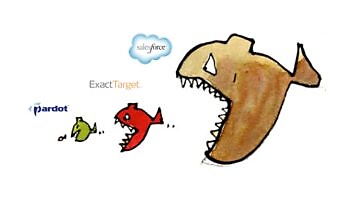They finally made their move.
Ever since Salesforce announced the Marketing Cloud, the question everyone has been asking is: when will they buy a marketing automation vendor to fill that elephant-shaped hole?
Then Oracle, their arch-frenemy, bought Eloqua and the stakes went up.
How long could Salesforce sit this one out?
And who would they buy?
Most B2B marketing agencies probably had a betting pool going and in this sense (and only this sense), Velocity is no different. For what it’s worth, my money was on Marketo despite the rumour mill that said hell would freeze over first (not sure why).
So I lost my money. Which is a very small thing compared to the money that Exact Target’s shareholders made. This was a big-ass multiple.
It was also, like so many of Salesforce’s moves over the years, a really smart play. That’s not a comment on the specific acquisition target – Exact Target with Pardot inside. This may well be a brilliant fit (who the hell am I to say?) – but, more importantly, Salesforce really needed to fill the marketing automation gap to make the Marketing Cloud a whole, credible offer – and to complete their coverage of the entire sales-marketing funnel.
I don’t know about you, but I’ve been really impressed by Salesforce’s strategy. They’ve managed to take what could have been a peripheral sales application and turned it into a suite of integrated tools that sit right at the heart of the enterprise. Just the big three: Sales Cloud, Service Cloud and Chatter are a killer trinity. It all seems obvious in retrospect but it took real vision and big balls.
[Disclaimer time: Salesforce is a client. Marketo was a client (and are still friends). Silverpop is a client. None of this really matters as I’m not sharing any inside information (I don’t have any) and I’m writing this as a (part-time) industry watcher NOT as a champion of any vendor. Just sayin’.]
So what does this deal mean to B2B marketers?
It means good things:
It means that the marketing technology silos are really falling.
It means that the comprehensive marketing platforms we all really want are starting to arrive.
It means the burden of integrating so many apps and databases won’t fall on the marketers’ shoulders any more.
And it means that the giants can start to slug it out, driving faster innovation and (if competition works the way it’s supposed to work) lower prices.
It also means bad things:
That power is starting to consolidate around a few vendors. That can mean lock in. Which sucks.
It can also mean the kind of oligopoly that depresses innovation, as in, say, banking. (Boy does that market need a disruptor).
And it can hurt the innovative independents, making their prospects slow down before signing the contract.
This happens in every tech market as the ‘best of breeds’ give way to the integrated platforms. And, when it works, it can lead to an efficient market that’s well served by vendors who are profitable enough to invest in things like innovation, consulting and customer support.
And all three of these are really needed in the whole revenue performance management space (do they still call it that?).
We need innovation because, no matter what anyone tells you, there are still gaps in every product.
We need consulting because none of this stuff is ‘plug and play’. It’s ‘figure out your goals, metrics and processes, then configure the tech to support them all. Then learn stuff and change it all.’ And every company can use help with that (which is why consultants like DemandGen, The Pedowitz Group and so many others are thriving).
And we need customer support because sales have far exceeded every vendor’s ability to hold hands.
So what’s next?
More consolidation.
More acquisition.
Some of the slower indies going to the wall.
Some of the more agile indies finding new niches to fill – and getting snapped up.
One thing to keep in mind: today, the intelligent combination of marketing automation and CRM confers a killer advantage to the early adopters who figure it out.
But once the platforms mature, best-practice processes and platforms will become standard. That means they won’t confer competitive advantage any more: they’ll be the price of entry.
When everyone raises their game, no one stands out.
So the leaders will have to look for the next big leap.
Which is what leaders do.
Other Reactions to the Deal:
Hey, I never said I invented newjacking:
Robert Rose gives his typically intelligent analysis in this CMI post: “Salesforce.com has an opportunity to connect the dots of customer engagement and collect the data — from the tippy-top awareness part of the funnel all the way down to brand evangelism.”
Ben Finklea of Volacci says it’s all about integration in this post: “As companies move beyond marketing automation as a standalone product and into a more integrated solution, I expect SalesForce.com’s entry into this space to shine a huge spotlight on the integration issue”
Ann Handley of Marketing Profs tweets: “I’d say orgs in our space have embraced #Newsjacking in a big way: I’ve had 2 dozen reactions to @salesforce @ExactTarget in my inbox today.” (Jeez, Ann, now I feel like a bandwagon chaser).

Enjoyed this article?
Take part in the discussion








Comments